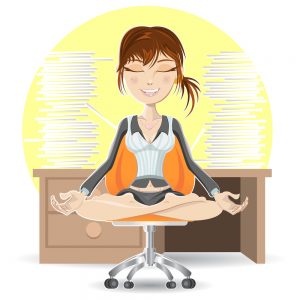Overworking and the stress associated with it can shorten lives. Many individuals become slaves to their work. They bring their work home and wherever they go. When the stressors of work are constantly on one’s mind, one’s overall health is risked especially with higher risks of high blood pressure and heart attack. It is important to set boundaries and properly utilize stress management and meditation skills to lessen stress. In addition, those who have a difficulty balancing work and play enjoy less of what life has to offer. This is why it is so important to establish a healthy balance and utilize Stress Management.

The article, “5 Tips for Achieving Work-Life Harmony During Busy Seasons” by Amy Vetter looks closely at how to balance work and home life and how to counter the negative effects of stress. Her target audience is for tax accountants during the busy tax season but applies to anyone dealing with deadlines. She encourages utilizing the numerous stress management techniques and tools available as well as meditation. She also emphasizes the importance of hobbies or other activities that allow the mind to find other things to reflect on. In addition she points out that boundaries are essential. She states that it is OK to say no to non vital work related requests and to prioritize tasks. Time management is also emphasized to maximize work efficiency. Overall, in regards to work stress and finding balance, she remarks
“Whether it’s on the intensive four-month audit, or the upcoming tax season, we all have busy seasons. The key to a healthy work-life is maintaining balance and not letting the work creep into other areas of your life. Work to eliminate those distractions so you can focus on what matters—you and your loved ones.”
“5 Tips for Achieving Work-Life Harmony During Busy Seasons”. Amy Vetter. March 3rd, 2023. CPA Practice Advisor.
To read the entire article, please click here
Commentary

Stress is a natural part of life but when it becomes chronic it can wear down the body. The body produces certain hormones to deal with stress in life. Usually these hormones are for fight or flight situations but when they are utilized for office and work settings, this constant red alert state can damage the body. It is hence important to utilize stress management in dealing with work stress by establishing boundaries, utilizing time management and finding time to give to family and friends. This may involve saying no from time to time to work requests or taking a day off or prioritizing but overall it is essential for long term health.
The Negative Effects of Job Stress on Mental Wellness
Job stress can have a severe impact on mental wellness. It can interfere with personal relationships, disrupt sleep patterns, cause anxiety, and lead to overall poor mental health. When individuals are stressed at work, they often bring that stress home with them, causing additional tension and strain on personal relationships. Additionally, stress can cause sleep disturbances, which can further exacerbate mental health issues. Over time, chronic stress can lead to anxiety disorders and depression, making it essential to take steps to prevent and manage job stress.
The Benefits of Work-Life Balance on Mental Wellness and Productivity
Achieving a proper work-life balance can have a significant impact on mental wellness and productivity. By prioritizing personal needs and time, individuals can reduce job stress and maintain a healthy mental state. When individuals have a well-rounded life outside of work, they can return to their job with a clearer mind and increased focus, leading to higher productivity levels. Additionally, work-life balance can lead to improved physical health, including better sleep patterns, increased physical activity, and decreased risk for chronic illnesses.
Tips for Achieving Work-Life Balance
Achieving work-life balance can be challenging, but there are several tips individuals can follow to help achieve it. One tip is to prioritize personal time and set boundaries around work responsibilities. This can include limiting the number of hours worked per week or designating specific days for personal activities. Additionally, individuals can utilize time-management techniques to maximize productivity during work hours, allowing for more leisure time outside of work. It is also crucial to maintain a healthy lifestyle by eating well, exercising regularly, and getting adequate sleep.
Strategies for Managing Job Stress and Stress Management
Managing job stress is essential for maintaining mental wellness. One strategy is to practice mindfulness techniques, such as meditation or deep breathing exercises, to help manage stress in the moment. Additionally, individuals can prioritize self-care activities outside of work, such as hobbies or spending time with loved ones, to help alleviate job stress. It is also important to communicate with colleagues and supervisors about job stressors and potential solutions to reduce stress levels. Ultimately Stress Management is key.
Techniques for Maintaining Mental Wellness

In addition to managing job stress, there are several techniques individuals can use to maintain mental wellness. One technique is to prioritize self-care activities, including exercise, healthy eating, and adequate sleep. Additionally, individuals can utilize therapy or counseling services to manage mental health concerns or issues related to job stress. It is also essential to maintain social connections and engage in activities that bring joy and fulfillment.
The Role of Employers in Promoting Work-Life Balance
Employers play a crucial role in promoting work-life balance for their employees. Employers can offer flexible work schedules, such as remote work or flexible hours, to allow employees to prioritize personal needs. Additionally, employers can offer mental health resources, such as counseling services or stress-management workshops, to support employees’ mental wellness. It is also crucial for employers to foster a healthy work culture that values work-life balance and encourages employees to prioritize personal time.
The Impact of Technology on Work-Life Balance
Technology has become a significant factor in work-life balance, often blurring the lines between personal and professional time. While technology has allowed for increased productivity and flexible work arrangements, it has also led to increased job stress and decreased personal time. It is essential for individuals to set boundaries around technology use, such as limiting work-related emails or notifications outside of work hours. Additionally, employers can encourage healthy technology habits and offer resources to support employees’ technology use.
Conclusion

Achieving a healthy work-life balance is crucial for maintaining mental wellness and overall productivity. By prioritizing personal needs and managing job stress, individuals can reduce the negative effects of job stress on mental health. Employers also play a vital role in promoting work-life balance by offering flexible work arrangements and mental health resources. Additionally, it is important to be mindful of technology use and set boundaries to promote personal time outside of work. Overall, prioritizing work-life balance is essential for maintaining a healthy and fulfilling life, both personally and professionally.
If you’re struggling to achieve a healthy work-life balance or manage job stress, consider seeking support from a mental health professional or reaching out to your employer for resources. Remember, prioritizing personal time and mental wellness is essential for overall happiness and productivity. Stress Management Consultants can also help teach important stress reducing techniques
Please review AIHCP’s Stress Management Consulting Certification and see if it meets your academic and professional goals. The program is online and independent study and open to qualified professionals seeking a four year certification in Stress Management Consulting.
Additional Resources
“Coping with stress: Workplace tips”. Mayo Clinic Staff. January 16th, 2021. Mayo Clinic. Access here
“How to Keep Work Stress from Taking Over Your Life”. Cindy Lamothe. October 30th, 2019. Healthline. Access here
“Balancing Work and Family”. WebMed Editorial Contributors. October 25th, 2021. WebMD. Access here
“8 Tips for Work-Life Balance”. April 27th, 2022. Health Essentials. Cleveland Clinic. Access here


